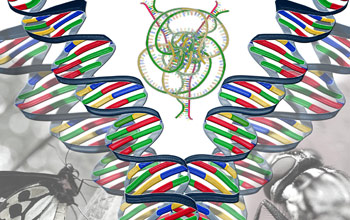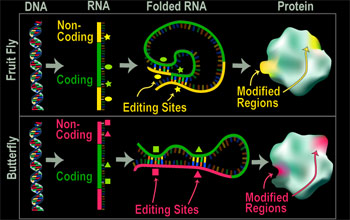All Images
News Release 05-041
Mechanism of RNA Recoding: New Twists in Brain Protein Production
RNA loops and knots guide genetic modifications
This material is available primarily for archival purposes. Telephone numbers or other contact information may be out of date; please see current contact information at media contacts.

A new study has uncovered the rules of RNA recoding--a genetic-editing method cells use to expand the number of proteins assembled from the DNA code. The shape a particular RNA molecule adopts determines how the molecule gets edited inside cells.
Credit: Nicolle Rager, National Science Foundation
Download the high-resolution JPG version of the image. (587 KB)
Use your mouse to right-click (Mac users may need to Ctrl-click) the link above and choose the option that will save the file or target to your computer.

DNA (left) encodes the instructions for making protein, but cells can't read them directly. Instead, the DNA code is copied first into RNA in a process called transcription. RNA includes coding regions that direct protein assembly (green) and non-coding regions--called introns--that play a regulatory role (yellow, pink). By studying the RNA code for the nervous- system protein, synaptotagmin, in several different insects, Reenan uncovered the general rules of RNA editing. Each insect's RNA folds differently and the structures determine how the molecules get edited inside cells.
This figure illustrates editing of fruit fly and butterfly RNA molecules. RNA folding brings regulatory regions (yellow, pink shapes) together with editing sites (green shapes). The resulting "knots" of fruit fly RNA (upper panel) and "loops" of butterfly RNA (lower panel) guides editing enzymes to sites destined for modification. RNA editing lets cells produce a variety of different proteins from a single DNA code (right). The altered proteins often have different functions from their unmodified counterparts.
Credit: Nicolle Rager, National Science Foundation
Download the high-resolution JPG version of the image. (390 KB)
Use your mouse to right-click (Mac users may need to Ctrl-click) the link above and choose the option that will save the file or target to your computer.


